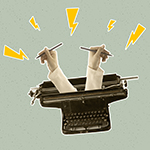Reanimating Data Method
Presenter(s): Rachel Thomson

How can we approach archives in creative ways, and establish coproduction of meanings?
Archival materials can be understood very broadly: newspapers, photographs, letters, official documents, diaries, and personal memorabilia.
In this guide we share the Reanimating Data approach: four methodological strategies for engaging in secondary analysis, assessing, and interpreting archives.

.
Re-asking (strategy 1)
One productive way into an archive is through the questions asked (rather than the answers provided). Focusing on questions can tell us a great deal about how the issues or problems were framed by researchers. They can also prompt us to answer the questions again for ourselves – giving us a way of connecting present and past.
Facing pages and pages of transcribed archival materials can be overwhelming. Treating the archive playfully and focusing on questions helps make the archive more accessible.
The facilitator could throw the pages into the air and ask participants to find questions that resonate with them. Once chosen, the participants engage with the questions as a starting point for discussion.
> Download worksheet – read these data extracts from the WRAP project (focusing on work and education plans) and find a question that jars or speaks to you. Underline the question and spend 5 minutes free writing your answer or reaction to it.
The method also works well as a focus group activity. First, a group is asked to identify a question or two. Then, sitting in a circle, the group is asked to pose the question they had chosen to the person sitting on their left.
So as a method, re-asking questions from archived materials can be a generative method that:
- Provides prompts for focus group discussion and / or creative work.
- De-centres the researcher.
- Can give permission to explore less talked about areas.
Collaging (strategy 2)
Collaging involves working with data alongside other relevant archival sources as raw materials for creative work – including the creation of posters, fanzines (magazines) and poems.
Poetry:
Participants are asked to take scissors and chop the material up. They then arrange phrases on a page in order to create their own poem. The poems would then be a focus for conversation and discussion, with participants talking both about their responses to the source material and the story that they were telling for themselves.
> Download worksheet – using your scissors cut up the text and find phrases and words that appeal to you and form these into a data poem.
Images:
We can create collages, using a range of source materials. Collages can focus on a particular topic or an analytic task (such as comparing past and present). Like the data poems, the collage can be a starting point for new conversations
> Download worksheet – working with words and images (on gender and work from 1988/9) can you create a collage exploring the changing ways in which young people imagine work?
Re-voicing (strategy 3)
Choosing and then re-voicing words of someone else (from the archival text) is a safe way of exploring issues.
Participants can re-voice by performing the material, for example, a story can be told as if it is a funny account. But it could also be told again in a very serious way. This can help to get deeper into the material, and find different kinds of meanings.
> Download worksheet – select a couple of lines from one of the extracts in this worksheet, and try delivering these lines as if you were telling a joke, or you were angry, were saying it to someone you are very close to, or as if you were a news broadcaster.
You can record a video of yourself re-voicing, watch the recording, and note down the differences in each performance.
The re-voicing method allows participants a safe way of telling their story through telling the story of someone else.
As a method re-voicing
- Creates opportunities for participants to analyse, interpret and comment on the data as a co-researcher.
- An invitation to participants to tell new stories, but without any pressure to do so.
- Can provide participants with a sense of connection, solidarity and sense-making.
- Decentres the researcher and can allow participants to lead the research agenda.
Re-collecting (strategy 4)
The method is based on the idea that participants exposed to archived materials may be inspired to tell their own stories, and to contribute their own material to archives in the making.
The invitation to contribute to the archive of the future could be something very simple and accessible. Participants can contribute stories and experiences anonymously, for example:
- Filling a pinata with messages for others.
- Creating patchwork squares for a banner.
- Uploading objects into the digital archive.
- Creating a performance, where participants weave their own stories with those of the archive.
Re-collecting:
- Gives participants permission and confidence to tell their own stories or to research the stories of others.
- New stories emerge in conversation with old stories.
- Participants contribute towards a collective storytelling project.
- Can use a range of expressive art forms (including non-verbal).
> Download worksheet – find something in your belongings that captures your personal or work identity, or your aspirations, and free write about it using questions provided.
When working with a group in class, consider:
- What source materials can you access.
- What could create meaningful time-binds for your work, connecting ‘data’ with ‘audiences’?
- How might the different stakeholders think and feel about the ‘archive’? Boundary objects can be different things to different people.
- Making safe spaces for the work.
- What are the data? What/whose is the analysis?
How to make the space safe:
- Are the materials covering a sensitive area, or young people?
- Listen, support and encourage each other.
- Share.
- Everyone has the right to pass and to choose not to participate.
- Only share data that you have permission to share both in the workshop and afterwards.
About the author
Rachel Thomson is a sociologist whose research interests include the study of the life course and transitions, as well as the interdisciplinary fields of gender and sexuality studies. She is a methodological innovator and is especially interested in capturing lived experience, social processes and the interplay of biographical and historical time.
- Published on: 5 June 2023
- Event hosted by: Sussex University
- Keywords: Generative method | Archieves |
- To cite this resource:
Rachel Thomson. (2023). Reanimating Data Method. National Centre for Research Methods online learning resource. Available at https://www.ncrm.ac.uk/resources/online/all/?id=20804 [accessed: 13 December 2025]
⌃BACK TO TOP



